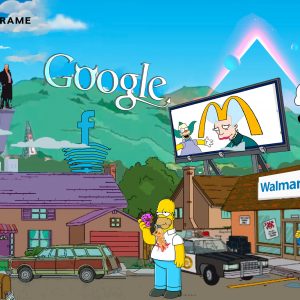How 1990s pop culture fuels conspiracy theories now
While those films in the 1990s that gave us allegories about real events were not meant as historical documents, many of today’s conspiracy theories have their imaginative roots in pop culture.
Author:
18 February 2021

Two men sit facing each other in a room once grand but now dilapidated, as lightning flashes and rain pours outside.
The younger of them, Neo, is an alienated computer hacker, living in what he believes to be the late 20th century. His search for a mysterious force called “the matrix” has brought him into a seedy underworld of terrifying government agents and techno-goth outlaws, led by the enigmatic Morpheus.
When they finally meet, Morpheus offers Neo the answer he has been looking for: “The matrix is everywhere. It is all around us … It is the world that has been pulled over your eyes to blind you from the truth.”
“What truth?” asks Neo.
“That you are a slave, Neo. Like everyone else you were born into bondage. Into a prison that you cannot taste or see or touch. A prison for your mind.”
He offers Neo a choice between two pills. A blue pill to return him to his old, normal life, and a red pill to show him the horrifying truth about reality. “Unfortunately, no one can be told what the matrix is. You have to see it for yourself.”
Related article:
As global audiences who flocked to see The Matrix in cinemas in 1999 would discover, the truth was that Keanu Reeves’ Neo was living in a virtual reality simulation a few centuries into the future. In this world, intelligent machines have overthrown humanity and keep the survivors in an artificial dream state, in order to extract energy from their sleeping bodies. Morpheus, played by Laurence Fishburne, is part of a resistance group formed by rebels who have themselves escaped from the consensual hallucination and now fight to “wake up” a slumbering humanity.
Directors Lilly and Lana Wachowskis’ film combined action spectacle with intriguing philosophical and political allegory. In recent interviews, Lilly Wachowski revealed that the script’s themes of metamorphosis and self-realisation were profoundly inspired by the sisters’ personal journeys as transgender artists. The movie’s themes of machine control and blurred realities feel even more urgent in an era of giant tech companies and social media overload. The image of humans cocooned in a pacified, isolated state, while having their energy sapped by machine algorithms is a stark allegory for digital capitalism.
But the term “red pill” has also been adopted by the right wing, who use it to mean radicalisation and conversion to extreme views. While first used by the online fringes, it has become so mainstream that after it was co-opted by both Ivanka Trump and Elon Musk in May 2020, Lilly Wachowski angrily tweeted “F– both of you”.
But The Matrix is not the only film released in 1999 to have its imagery and narrative extracted, manipulated and incorporated into the political imagination of contemporary right-wing conspiracy movements. Director Stanley Kubrick’s final film Eyes Wide Shut prefigured QAnon beliefs with its scenes of masked elites performing bizarre rituals. David Fincher’s Fight Club – intended as a satirical comment on the glamorisation of violence – has instead been embraced by the misogynist “manosphere”.
Dark forces
Fiction about conspiracies and paranoia, which focus on characters who believe there are dark forces out to get them, have a complex relationship with real-world political beliefs. Stories about hidden elites and covert plots are used as narrative devices to create mystery and suspense. They are generally deployed as allegories and myths about real-world events. They are often not intended by their creators to be taken seriously as historical documents or political facts.
In practice, however, the line between pseudo fact and pulp fiction is blurred. Many of the online disinformation campaigns of today have their imaginative roots in pop culture.
Related article:
For example, the prolific conspiracy theorist David Icke has built a loyal following with his claim that the world is secretly run by reptilian aliens who are masquerading as human beings. This entire premise was plagiarised from the plot of the 1980s sci-fi television show V, along with other weird fiction stories about lizard people.
The Matrix capped a decade in which filmmakers and writers were paranoid about governments, corporations, new technology such as the internet and the very nature of reality itself. And this was not just a singular fixation of Hollywood and American popular culture. The Matrix itself drew on global influences. It has been said that copies of Scottish writer Grant Morrison’s The Invisibles were passed around on set for design inspiration. In this epic cult comic book, a group of stylish anarchist revolutionaries fight across time and space against ultra-dimensional forces of control and oppression. Many of the Wachowskis’ action sequences paid homage to the 1995 Japanese anime Ghost in the Shell, a film about artificial intelligence and the question of what it means to be human.
New world order
The 1990s saw the consolidation of a new post-Cold War, globalised economy. This extended to popular culture, as new markets opened up in the former Soviet bloc countries and China.
South Africa itself underwent this integration into mass culture, as the fall of apartheid meant the end of a cultural boycott that prevented many films and TV shows from being seen. This erosion of Calvinist censorship meant the country was flooded with VHS tapes, books and magazines about aliens, conspiracies and the paranormal.
On 11 September 1990, US President George HW Bush gave a speech titled “Toward a new world order”. For Bush, this meant a world of neoliberal economics, underpinned by American military power. Bush, along with political theorists such as Francis Fukuyama, believed that the 1990s was the “end of history”.
They imagined that consumer capitalism and liberal democracy had proved themselves to be the final, perfected form of human civilisation. In the future, the only conflicts would be over economics, not ideologies. The primary role of government was to benefit corporations and the wealthy, and to defend the market above all else.
Related article:
But the term “new world order” (NWO) had a very different connotation when used outside of elite policy circles. For many armed right-wing militias, the NWO was a shadowy cabal of industrialists and politicians, who secretly planned to install a world government. According to legend, the NWO used unmarked black helicopters and ruthlessly persecuted anyone who disobeyed their covert agenda. In 1995, Timothy McVeigh carried out the Oklahoma bombing, which killed 168 people, under the belief that he was attacking the local headquarters of the NWO.
Far right paranoia also overlapped with a more general belief in aliens and unidentified flying objects (UFOs). According to these conspiracies, the US government, and others, were deliberately hiding the existence of a race of sinister grey aliens. It was believed that aliens were abducting innocent members of the public, while also working with human collaborators in secret military bases like Nevada’s Area 51.
These fringe beliefs were signal-boosted by their use in popular culture. For example, the myth that the US military secretly retrieved a downed alien spacecraft in New Mexico in 1947 became a major plot point of the highest-grossing film of 1996, Independence Day.
Related article:
Youth culture was also awash with a generalised sense of suspicion. Many rap and electronic artists incorporated references to secret plots and aliens into their songs. The two most influential alternative rock albums of the decade, Nirvana’s Nevermind and Radiohead’s OK Computer boasted lyrics such as “just because you’re paranoid, don’t mean they’re not after you”, and song titles such as Paranoid Android.
Political fear about the status quo was not just the terrain of reactionaries and wide-eyed UFO-believers. Leftists worried about the hidden underbelly of the shiny new neoliberal order over which Bush rhapsodised. They expressed anxieties about new technologies of control and surveillance, the dehumanising effects of consumerism and the continued ruthless exploitation of the Global South.
The decade’s anxiety was counterposed by optimism over the transformative power of computer technology. The 1990s was the first period in which the internet was available to the public, which inspired hopes that this would free information from government and corporate control. This utopian perspective, however, also meant that conspiracy theories were often seen as eccentric, harmless folklore or esoteric wisdom, rather than active misinformation.
This uncritical embrace of cyber culture would diminish in the early 2000s, as the internet became increasingly dominated by corporations. And, as recent years have taught, the unregulated proliferation of fringe beliefs has had precisely the opposite effect of human liberation, instead fuelling dangerous cult-like movements, such as QAnon.
I want to believe
In the 1990s, filmmakers still saw the conspiracy fringes as an imaginative space to mine for story ideas. This often resulted in a problematic blurring of history and wild speculation.
In 1991, American director Oliver Stone released the historical epic JFK. The film focuses on Jim Garrison, played by Kevin Costner, a heroic district attorney investigating the assassination of US President John F Kennedy in 1963. In the course of his research, he uncovers proof of a plot in which rogue elements in the military and Central Intelligence Agency murder Kennedy after he decides to end the Cold War with the Soviet Union.
Stone claimed the film was intended as a “fable” and counter to official narratives, rather than a reflection of factual events. But even sympathetic critics at the time of the film’s release argued that the director was playing loose with historical facts. In the film, Garrison is portrayed as a scrupulously honest crusader for the truth. In real life, however, many observers regarded Garrison as an “egoist and megalomaniac” who provided no credible case to back up his allegations.
Related article:
The success of JFK encouraged TV executives to greenlight The X-Files, which started airing in 1993. Created by Chris Carter, the series focuses on two FBI agents assigned to investigate unexplained and strange cases. Over the course of nine seasons, compassionate but sceptical agents Dana Scully (Gillian Anderson) and loose-cannon conspiracist Fox Mulder (David Duchovny) encounter a range of paranormal entities and strange events. They also uncover a vast conspiracy, where members of the world’s political elites are secretly working with aliens to subjugate humanity.
At its peak of popularity, The X-Files did more to expose mainstream culture to the conspiracy fringes than anything before it. Catchphrases such as “trust no one”, “ I want to believe” and “The truth is out there” became ubiquitous marketing slogans. It even inspired a range of copycat shows, such as the short-lived Dark Skies, which weaved real people like members of The Beatles and psychedelic pioneer Timothy Leary into its alien conspiracies.
In 1995, Fox, the channel that produced The X-Files, even aired a “documentary” called Alien Autopsy: Fact or Fiction? with black-and-white footage purported to be actual evidence of the US military performing research on an alien corpse. As is to be expected, the video was later proved to be made as part of a convoluted hoax by an eccentric television producer.
Carter and other show writers expressed scepticism about the validity of UFO conspiracies, even including occasional humorous episodes that satirised those beliefs. At the same time, they freely drew on anonymous internet posts and wild claims made on talk radio to inspire story ideas.
This means that the politically liberal writers of the series incorporated far-right paranoia about the government in their plots. At the time, US “patriot” militias believed the US Federal Emergency Management Agency (FEMA), which deals with natural disasters, was secretly establishing prison camps and conducting bizarre human experiments. This became a recurring plot device on The X-Files, as FEMA is used by the alien conspiracy as a front to release a deadly virus spread by bees. The virus is intended to cull and weaken humanity so the aliens can take over.
Watching the episodes with the FEMA disease plot in 2021 is uncanny. It echoes perfectly the paranoid beliefs of anti-vaxxers, who regard Covid-19 as itself a plot released by the new world order to force a “great reset” of society. You have to wonder how much of the imaginative narrative of contemporary paranoia was specifically seeded by The X-Files, even while the show was itself drawing on existing fringe ideas of its time.
New technology, old repression
But other 1990s paranoia culture was rooted in more grounded and immediate fears about the future. A wave of technological thrillers, such as The Net (1995) and Enemy of the State (1999), speculated on the dangers posed by the internet and technological surveillance. These films hint that new forms of technology could be used to reinforce old forms of domination and repression.
This idea was most radically presented in the 1995’s Strange Days. Directed by Kathryn Bigelow and starring Angela Bassett and Ralph Fiennes, the film was a box office disappointment on its initial release, but has since gained a cult following. In 1999 Los Angeles, virtual reality technology is a street drug people use to voyeuristically experience dangerous situations and get an “extreme taste of reality”.
Related article:
The technology is the background for a story that focuses on racial inequality and police brutality, as two Los Angeles police officers murder a Black rapper, Jeriko One, and then attempt to cover up a recording of their crime. Its scenes of American cities full of militarised police and civil insurrection anticipated the 2020 George Floyd protests.
The film shows the greatest threats to society as coming from armed agents of the state and institutionalised racism, not malevolent grey aliens or other uncanny beings.
While the grunge fashions, brick-sized cellphones and dial-up modems of 1990s culture may seem quaint, its pervasive concern with suspicion and alienation has an uncomfortably close resonance with our current social and political climate.






